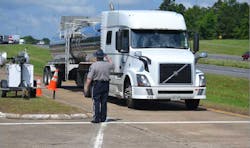International Roadcheck May 5-7; emphasis on driver requirements
The Commercial Vehicle Safety Alliance’s (CVSA) International Roadcheck 2020 will take place May 5-7. International Roadcheck is a high-volume, high-visibility three-day enforcement initiative that highlights the importance of commercial motor vehicle safety through roadside inspections. Over that 72-hour period, commercial motor vehicle inspectors in jurisdictions throughout North America will conduct inspections on commercial motor vehicles and drivers.
Each year, International Roadcheck places special emphasis on a category of violations. This year’s focus is on the driver requirements category of a roadside inspection. According to the U.S. Federal Motor Carrier Safety Administration’s (FMCSA) fiscal 2019 data, of the 3.36 million inspections conducted, 944,794 driver violations were discovered, of which 195,545 were out-of-service conditions.
“With last year’s federal electronic logging device (ELD) full-compliance mandate in the U.S., the Alliance decided that this year’s International Roadcheck would be the perfect opportunity to revisit all aspects of roadside inspection driver requirements,” said CVSA President Sgt. John Samis with the Delaware State Police.
During International Roadcheck, CVSA-certified inspectors primarily conduct the North American Standard Level 1 Inspection, a 37-step procedure that includes two main inspection categories: an examination of driver operating requirements and vehicle mechanical fitness. A third category, hazardous materials/dangerous goods, may also be part of a Level I Inspection. Depending on weather conditions, available resources or other factors, inspectors may opt to conduct the Level II Walk-Around Driver/Vehicle Inspection, Level III Driver/Credential/Administrative Inspection or Level V Vehicle-Only Inspection.
An inspector will start each inspection procedure by greeting, interviewing and preparing the driver. The inspector will collect and verify the driver’s documents, identify the motor carrier, examine the driver’s license or commercial driver’s license, check record of duty status and review periodic inspection report(s). If applicable, the inspector will check the Medical Examiner’s Certificate, Skill Performance Evaluation Certificate and the driver’s daily vehicle inspection report. Inspectors will also check drivers for seat belt usage, illness, fatigue, and apparent alcohol and/or drug possession or impairment.
The vehicle inspection includes checking critical vehicle inspection items such as: brake systems, cargo securement, coupling devices, driveline/driveshaft components, driver’s seat (missing), exhaust systems, frames, fuel systems, lighting devices, steering mechanisms, suspensions, tires, van and open-top trailer bodies, wheels, rims and hubs, and windshield wipers. Additional items for buses, motorcoaches, passenger vans or other passenger-carrying vehicles include emergency exits, electrical cables and systems in engine and battery compartments, and temporary and aisle seating.
If no critical vehicle inspection item violations are found during a Level I or Level V Inspection, a CVSA decal will be applied to the vehicle, indicating that the vehicle successfully passed a decal-eligible inspection conducted by a CVSA-certified inspector. However, if a required rear impact guard is inspected during a Level I or Level V Inspection and violations are present, a CVSA decal will not be issued.
If an inspector does identify critical vehicle inspection item violations, he or she may render the vehicle out of service if the condition meets the North American Standard Out-of-Service Criteria. This means the vehicle cannot be operated until the vehicle violation(s) are corrected. A driver can also be placed out of service for driver credential-related issues or driver conditions, such as fatigue or impairment.
In the past, International Roadcheck usually took place during the first week of June. However, this year, International Roadcheck was moved up by one month, from June to May, when the weather may be more favorable for many jurisdictions.
“Announcing the dates of International Roadcheck has always been a deliberate, thoughtful and purposeful decision by the Alliance,” said Sgt. Samis. “By announcing the dates in advance, we hope to remind motor carriers of the importance of proactive vehicle maintenance and remind drivers to be prepared for inspections and to always conduct pre- and post-trip inspections. We want every vehicle and driver inspected during this initiative to pass inspection with no violations.”
Sgt. Samis added, “We’re aware that some drivers opt to stay off roadways during the three days of International Roadcheck. Although there is certainly an increase in the number of inspections conducted during International Roadcheck, it’s important to remember that inspections are conducted every day of the year. Inspectors will be inspecting commercial motor vehicles the day before International Roadcheck starts, the day after it ends, as well as any other day of the year.”
International Roadcheck is the largest targeted enforcement program on commercial motor vehicles in the world, with approximately 17 trucks and buses inspected, on average, every minute in Canada, Mexico and the U.S. during a 72-hour period. Since its inception in 1988, more than 1.6 million roadside inspections have been conducted during International Roadcheck campaigns.
About the Author
Fleet Owner Staff
Our Editorial Team
Kevin Jones, Editorial Director, Commercial Vehicle Group
Cristina Commendatore, Executive Editor
Scott Achelpohl, Managing Editor
Josh Fisher, Senior Editor
Catharine Conway, Digital Editor
Eric Van Egeren, Art Director
